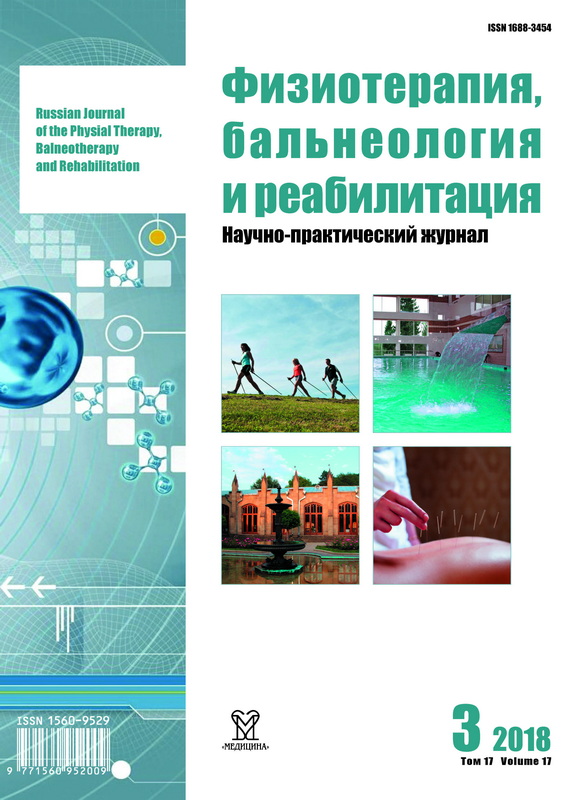The experience of application of prolonged craniopuncture in acute period of ischemic stroke
- 作者: Molchanova E.E.1
-
隶属关系:
- Amur State Medical Academy
- 期: 卷 17, 编号 3 (2018)
- 页面: 153-156
- 栏目: Original studies
- ##submission.datePublished##: 15.09.2020
- URL: https://rjpbr.com/1681-3456/article/view/43615
- DOI: https://doi.org/10.18821//1681-3456-2018-17-3-153-156
- ID: 43615
如何引用文章
全文:
详细
The purpose of this research was to study the effect of prolonged craniopuncture on the rate of regression of the neurological deficit, the degree of adaptation to daily life, and the level of motivation among patients in the acute period of ischemic stroke. All patients (60 people) were divided into 2 groups, identical by sex, age and severity of the stroke. In the main group of patients (n=30) prolonged scalp therapy was performed simultaneously with classical acupuncture. The peculiarity of this modification of craniopuncture is the use of seven main areas of the scalp with their symmetrical stimulation and duration of exposure for up to 4 hours. Patients of the control group (n=30) underwent acupuncture in combination with scalp therapy according to the classical method. Assessment of the severity of neurological deficit was carried out on the scale NIHSS, while Barthel ADL index was used to assess the patient's daily live activities after stroke. The level of motivation among the patients was studied by using the questionnaire test “Motivation for Success and Motivation for Fear of Failure”. Monitoring was carried out on the 1st and 15th day from the start of treatment. In the main group of patients, the reduction in the severity of the neurological deficit occurred on the 15th day according to the data NIHSS scale was 5.0 (64,9%), the Barthel index increased by 31.0 points (55,1%). In the control group, similar indicators were 3.5 (50,7%) (on the NIHSS scale) and 23.5 points (40,5%) (Barthel's index). Both groups of patients experienced an increase in the level of motivation and were already oriented to success, but in the main group, these changes appeared to be more significant. Thus, the use of prolonged craniopuncture significantly accelerates the restoration of lost functions and the adaptation of patients to everyday life, in comparison with the classical method of scalp therapy, and has a beneficial effect on increasing the level of patients’ motivation.
作者简介
Elena Molchanova
Amur State Medical Academy
编辑信件的主要联系方式.
Email: helendok@mail.ru
MD, PhD, Associate Professor of Department of Faculty and Polyclinic Therapy
俄罗斯联邦, Blagoveschensk参考
- Bokeria L.A., Stupakov I.N., Gudkova R.G. Successes and problems of Russian cardiosurgery. Zdravookhranenie. 2012; (3): 24–33. (In Russ.)
- Starodubtseva O.S., Begicheva S.V. Analysis of the incidence of stroke using information technology. Fundamental’nye issledovaniya. 2012; (8-2): 424–7. (In Russ.)
- European Stroke Organization. Guidelines for Management of Ischaemic Stroke and Transient Ischaemic Attack 2008.
- He K., Zhang H., Wu Q.M. et al. The combined application of scalp and body acupuncture by stages for low limb dysfunction of patients with apoplexy. Zhongguo Zhen Jiu. 2012; 32(10): 887–90. (In Chinese)
- Hsing W.T., Imamura M., Weaver K. et al. Clinical effects of scalp electrical acupuncture in stroke: a sham-controlled randomized clinical trial. J. Altern Complement Med. 2012; 18(4): 341–6.
- Zhang S., Zhang L.H., Wang Y.J. et al. Effects of synchronous treatment of bilateral scalp acupuncture and rehabilitation training on activities of daily life in patients with cerebral infarction at acute phase. Zhongguo Zhen Jiu. 2014; 34(9): 837–40. (In Chinese)
- Staroverov A.T., Barashkov G.N. Acupuncture in anesthesiology and resuscitation. Saratov, 1983. 222 p. (In Russ.)
- Yu Zhi Shun, Sai Xue Bo, Yu Hui Min Study of the way of acupuncture according to methods of scalp acupuncture in stroke treatment. Zhen Jiu. 1993: 36–7. (In Chinese)
- Tang Qiang Treatment and rehabilitation of strokes with acupuncture. Heilongjiang, 2012. 171 p. (In Chinese)
- Tang Qiang, Zhu Luwen, Ye Tao, Lin Yuhuang The new strategy of early rehabilitation of stroke. The 11th Sino-Russia Forum of biomedical and pharmaceutical science. Harbin, 2014: 48–9.
- Goldstein L.B., Bertels C., Davis J.N. Interrater reliability of the NIH stroke scale. Arch. Neurol. 1989; 46: 660–2. DOI: 10.1001/ archneur.1989.00520420080026.
- Duncan P.W., Jorgensen H.S., Wade D.T. Outcome measures in acute stroke trials: a systematic review and some recommendations to improve practice. Stroke. 2000; 31(6): 1429–38.
补充文件






